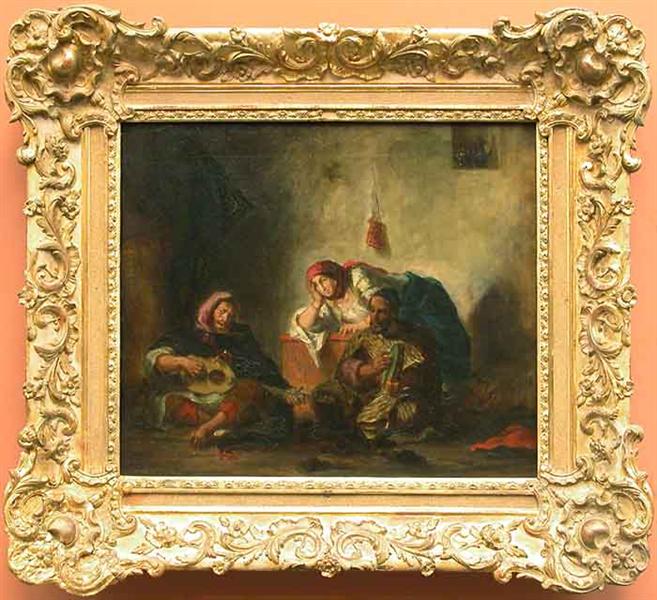Description
Eugène Delacroix's 1847 painting "Jewish Musicians in Morocco" is one of the most fascinating manifestations of his engagement with exotic themes and world cultures. Reflecting Delacroix's immersion in North African culture, this painting is not only a testament to his technical mastery and interest in everyday life, but also a window into the cultural diversity of his time.
In the painting, a group of Jewish musicians dressed in colorful traditional costumes appear to come to life thanks to the vibrant color palette used by the artist. The bold use of color is one of the most distinctive features of his work. Deep reds, vibrant greens, and golden hues combine to create a rich and evocative atmosphere that captures not only the essence of music, but also the warmth of human interaction. This color scheme pays homage to the culture that Delacroix immersed himself in during his trip to Morocco, as well as to the Romantic painting tradition that explores the sublime and the exotic.
The composition is equally remarkable, arranged in a way that guides the viewer’s eye through a visual narrative. The musicians are grouped together, playing different instruments that seem to resonate with a palpable energy. At the center, one musician stands out, holding his instrument with a posture that suggests both technical prowess and deep emotional connection. This figure, surrounded by his companions, represents not only individuality, but also the sense of community inherent to Moroccan Jewish music and culture.
The characters, each with vivid expressions and in various postures, seem to be engaged in a musical dialogue, creating a liveliness that is characteristic of the Romantic style. Delacroix, known for his ability to render movement and emotion, succeeds in capturing the essence of this cultural encounter. The attention to detail in the costumes, instruments and expressions is a hallmark of his analytical and sensitive approach to the depiction of life.
Through Jewish Musicians in Morocco, Delacroix also reflects his interest in the cultural diversity and multiple identities that make up the society of his time, at a time when Europe was beginning to open up to Eastern and African influences. This work can be seen as part of a broader movement in 19th-century art that advocated the exploration of the exotic and the unknown, often through the lens of fascination and romanticism.
Although the work is anchored in the context of Jewish life in Morocco, it invites the viewer to reflect on the universality of the human experience through music. The very musicality of the work is presented as almost tangible, enveloping the viewer in a visual symphony.
Ultimately, "Jewish Musicians in Morocco" is not just a representation of a specific moment in the cultural life of a community; it is a splendid example of how Delacroix, through his style and technique, manages to capture the essence of exoticism and the rich diversity of human experience in an age of cultural and artistic openness. This work, along with others from the same period, reaffirms the relevance of art as a means of intercultural dialogue and appreciation of the richness of humanity.
KUADROS ©, a famous painting on your wall.
Hand-made oil painting reproductions, with the quality of professional artists and the distinctive seal of KUADROS ©.
Painting reproduction service with satisfaction guarantee. If you are not completely satisfied with the replica of your painting, we will refund 100% of your money.

